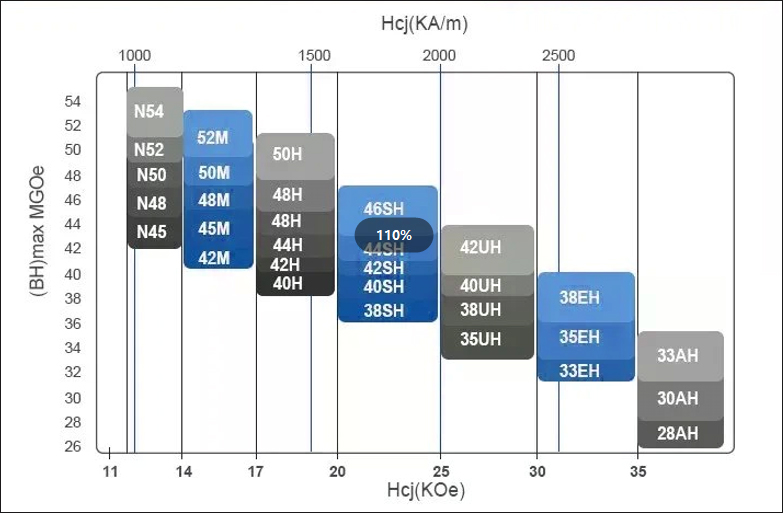0769-23388351
Toggle Navigation
Neodymium magnets are a very widely used type of rare-earth permanent magnets. Due to their extremely high magnetic properties, neodymium magnets have a wide range of applications in industry and daily life. However, the magnetic properties of neodymium magnets are sensitive to temperature, so understanding their temperature limitations is essential for use and storage.
Temperature Performance of Neodymium Magnets
Neodymium magnets have an extremely high magnetic energy product (BHmax) at room temperature, which makes them the strongest commercially available magnets. Their strong magnetic properties have led to a wide range of applications in electronics, motors, sensors and medical devices. However, one of the main drawbacks of neodymium magnets is their sensitivity to temperature.
Curie temperature is the temperature at which a material loses its magnetic properties. For neodymium magnets, the Curie temperature is usually between 310°C and 370°C. Above this temperature, neodymium magnets will completely lose their magnetic properties. This is an irreversible process and the magnet cannot regain its magnetic properties even after cooling.
The maximum operating temperature is the highest temperature at which a magnet can continue to operate without significant loss of magnetic properties. For neodymium magnets, this temperature range is usually between 80°C and 230°C, depending on the grade of magnet. Different grades of neodymium magnets have different temperature stability. For example, N35 magnets have a maximum operating temperature of about 80°C, while N52 magnets have a maximum operating temperature of about 60°C. High-temperature grades of neodymium magnets, such as H, SH, UH, EH, and AH, have maximum operating temperatures that can reach 150°C to 230°C.
Neodymium Magnet Grade Characteristics Table

The performance of neodymium magnets at high temperatures decreases mainly in the following aspects:
1. Decrease in coercivity (Hc): The coercivity of neodymium magnets decreases with increasing temperature. This means that magnets are more easily demagnetized at high temperatures.
2. Decrease in Magnetic Flux Density (Br): Higher temperatures cause a decrease in the residual magnetic flux density of neodymium magnets, which reduces their magnetic field strength.
3. Decrease in magnetic energy product (BHmax): The magnetic energy product of neodymium magnets also decreases significantly at high temperatures.
In some applications, neodymium magnets inevitably need to work in high temperature environments. For example, in electric cars and wind turbines, the motor generates a lot of heat when it works, and the magnet must be able to withstand these high temperature environments. To solve this problem, the following measures can be taken:
1. Selection of high-temperature grade magnets: according to the specific application requirements, select appropriate high-temperature grade magnets, such as SH, UH, EH, etc.
2. improve the cooling system: add cooling system in the equipment design to ensure that the magnet working temperature does not exceed its maximum working temperature.
3. Use alternative materials: In extreme high temperature environments, consider using other types of magnets, such as samarium cobalt (SmCo) magnets, which have better high temperature performance, but slightly lower magnetic properties than neodymium magnets.
Related articles added;
Neodymium Working Temperature Range (Rating)
Temperature coefficient and characteristic curve of neodymium magnet
This product is a polished ferrite magnet, round shape, It looks very beautiful, all magnet products of our company support customization, such as shape, material, size, magnetic properties, we will do our best to meet customer needs....
This is a ferrite magnetic rod specifically designed for antenna applications. It has a cylindrical shape and is also commonly referred to as an industrial inductance core. With a diameter of 2.9 mm and a height of 25.4 mm,...
This product is a gas pipe magnet, made of ferrite, radial four-pole magnetization, product specifications are d9.7*4.7*12.4mm, d19.4*12.5*12.4, matching, customers who need samples send us an inquiry ....
This is a high-strength racetrack magnet produced by Courage magnet manufacturer, belonging to the custom type of magnet, that is, it is processed by bar neodymium magnet, length size 45mm, width 5.9mm, thickness 5.9mm, surface magnetic strength more than 3500 Gauss....
15mm ferrite magnet is a conventional size, the market is relatively large, mainly for the thickness of magnetization, can do multi-pole magnetization, that is, a surface multiple magnetic poles, can be used in many industries, such as packaging, leather goods, handbags, refrigerator magnets, fire doors, smart home, medical equipment, sensors, surface magnetic field intensity in more than 1000 gauss,...
Note that this is a thin ring neodymium magnet with radial magnetization. Most of the other powerful ring magnets of similar specifications you have seen are axial, so this is a special one. The outer diameter of the magnetic ring is 27mm, the same as the size of the commemorative coin, the inner diameter is 17mm, and the thickness is 1mm. The following picture is taken by Xiao Fu, the courage magnet manufacturer....
This sintered neodymium magnet radial magnetic ring has an outer diameter of 48 mm and dimensions of 48 x 40 x 2.5 mm. It is made from high-performance rare earth materials and offers excellent magnetic performance and stability....
This 6x2x2.5mm ring-shaped neodymium magnet is designed using a diameter-direction magnetization (radial magnetization) process, featuring a unique magnetic field distribution, making it ideal for high-precision magnetic sensing and sensor applications....